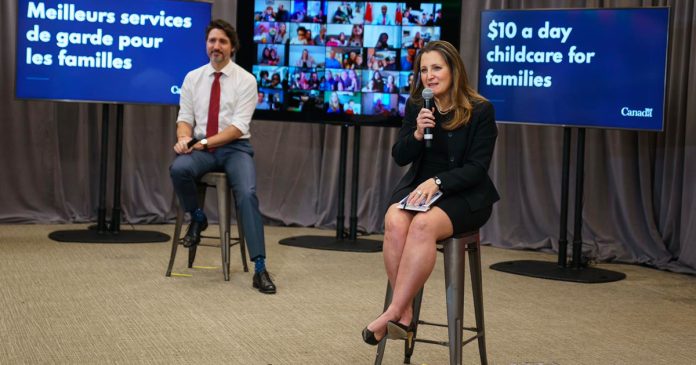By: Franco Terrazzano and Jay Goldberg
It’s one thing to pull out the credit card to pay for new shingles to patch a leaky roof in a storm. It’s another thing to pull out that credit card to buy a new big screen before the rain even stops.
That’s what Ottawa is doing by pilling up new program spending on top of its $1-trillion debt tab. Even worse, the feds are trying to pitch their debt-financed big screen as a good investment.
After record-high government spending in 2020, many economists have warned about the dangers of more debt.
“Canada cannot continue piling up public debt faster than GDP without risking a fiscal crisis,” said the University of Calgary’s Jack Mintz.
Prime Minister Justin Trudeau and Finance Minister Chrystia Freeland aren’t listening.
Within a few short years, the Trudeau government will have nearly doubled Canada’s national debt, thanks to Budget 2021.
The debt-to-GDP ratio will remain at about half of Canada’s entire economy for the next few years, significantly above pre-pandemic levels. And the only fiscal anchor the budget offers is a lame-duck commitment to unwind “COVID-related deficits and reducing the federal debt as a share of the economy over the medium-term.”
Professor of economics at McGill University William Watson also has some sobering thoughts.
“We need to understand that what we just went through was an emergency,” said Watson. “The federal government supporting millions of Canadians was not and should not become normal.”
But making higher government spending the new normal is exactly what Budget 2021 does. By 2026, Freeland will have increased permanent federal government spending by $100 billion. Instead of reining in spending after a temporary emergency, the government is using the cover of COVID-19 to embark on debt-fuelled spending binge.
“The fiscal situation we find ourselves in is that the government simply cannot afford major new spending programs,” said Philip Cross, a former chief economic analyst for Statistics Canada.
New and expensive federal programs took centre stage of the feds’ budget, with the government insisting it can somehow now afford to spend $30 billion on a national childcare scheme. To be clear, we couldn’t afford this pre-pandemic and with the government’s debt tab smashing through the $1-trillion ceiling, we certainly can’t afford it now.
And while the new deficit-financed spending on childcare may save parents some money today, Ottawa is essentially forcing parents to offload costs onto their children and grandchildren.
The debt-fueled 2021 budget is spooking Bay Street veteran Davis Rosenberg who is chief economist and strategist at Rosenberg Research.
“As an economist, I would probably give [the budget] a ‘D’ and I might be charitable on that score,” Rosenberg told BNN Bloomberg.
“I think that we’re definitely mortgaging our future with this extreme increase in debt.”
The Trudeau government is taking the wrong approach to a post-pandemic recovery. Experts such as Cross insist “the economy does not need more fiscal stimulus” and point to February and March job numbers to show that a post-pandemic recovery will unfold quite naturally as lockdowns end and restrictions are lifted.
If the feds want to help Canadians, they should toss aside their single-minded spend and borrow approach for one that lets us keep more of our own money.
For less than the cost of the government’s new stimulus program, the federal government could eliminate the GST for two years or cut its income tax-take in half for 2021. That’s support that can help families immediately, unlike many costly government programs.
The federal government has decided to borrow tens of billions of dollars to finance a stimulus package we don’t need and new programs that taxpayers can’t afford. Trudeau and Freeland should listen to the advice of economic experts and start to repair the state of Canada’s government finances.
Franco Terrazzano is the Federal Director and Jay Goldberg is the Interim Ontario Director of the Canadian Taxpayers Federation.





















